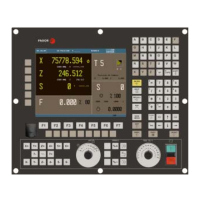·324·
Installation manual
CNC 8055
CNC 8055i
7.
CONCEPTS
SOFT: V02.2X
Axis setting
7.5.3 Proportional gain setting
In a "pure" proportional position loop, the velocity command of the CNC to control an axis is, at all
times, proportional to the following error (axis lag) which is the difference between its theoretical
and actual (real) position.
Velocity command = Proportional Gain x Following Error
axis parameter PROGRAIN (P23) sets the value of the proportional gain. Expressed in
millivolts/mm, it takes any integer between 0 and 65535.
Its value indicates the velocity command corresponding to a feedrate resulting in 1 millimeter
(0.03937 inch) of following error.
Sample
The maximum feedrate for a particular axis (rapid traverse G00) is 15 m/min, but we would like to
limit its maximum porgrammable machining feedrate (F) to 3 m/min with an axis lag of 1 mm at a
feedrate of 1 m/min (gain of 1 in metric).
axis parameter G00FEED (P38) must be set to 15,000 (15 m/min).
axis parameter MAXVOLT (P37) must be set to 9500 and the servo drive adjusted so as to provide
15m/min with a velocity command of 9.5 V.
axis parameter MAXFEED (P42) must be set to 3,000 (3 m/min).
Velocity command corresponding to F 1000 mm/min:
Velocity command = (F x 9.5V) / "G00FEED"
Velocity command = (1000 mm/min x 9.5V) / 15000 mm/min = 0.633V
Velocity command = 633 mV
Therefore, "PROGAIN" (P23) = 633.
Considerations to bear in mind
When setting the proportional gain:
• The maximum amount of following error allowed by the CNC for the axis is the value indicated
by axis parameter MAXFLWE1 (P21). When exceeded, the CNC issues the corresponding
following error message.
• The amount of following error decreases as the gain increases, but it tends to make the system
unstable.
• In practice, most machines show an excellent behavior with a unitary gain (gain of 1, 1 mm of
following error for a feedrate of 1m/minute).
Once the axes have been adjusted separately, the ones being interpolated together should be further
adjusted so their following errors are as identical as possible.
The more identical their following errors are, the more "round" the programmed circles will turn out.

